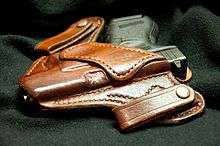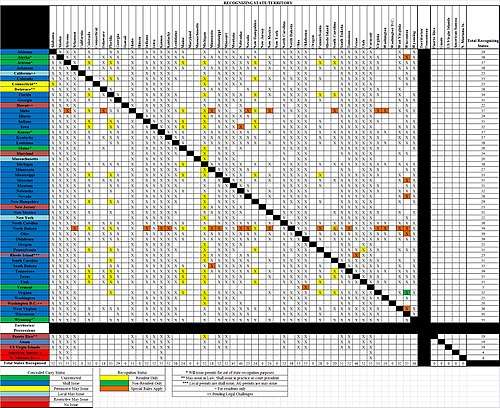Concealed carry

Concealed carry (carrying a concealed weapon (CCW)), refers to the practice of carrying a handgun or other weapon in public in a concealed or hidden manner, either on one's person or in close proximity. While most law enforcement officers carry their handguns in a visible holster, some officers, such as plainclothes detectives or undercover agents, carry weapons in concealed holsters. In some countries and jurisdictions, civilians are legally permitted to carry concealed handguns; in some, this may be the only legal way for a civilian to carry a handgun.
Countries
Brazil
Concealed carry in Brazil is generally illegal, with special carry permits granted to police officers allowing them to carry firearms off duty, and in other rare cases.[1]
Canada
The practice of CCW is generally prohibited in Canada. Section 90 of the Criminal Code prohibits carrying a concealed weapon unless authorized for a lawful occupational purpose[2] under the Firearms Act.[3] Section 20 of the Firearms Act allows issuance of an Authorization to Carry (ATC) in limited circumstances. Concealment of the firearm is permitted only if it is specifically stipulated in the conditions of the ATC, as section 58(1) of the Firearms Act allows a CFO to attach conditions to an ATC.
Provincial chief firearm officers (CFOs) may only issue an authorization in accordance with the regulations. Specifically, SOR 98-207 section 2 requires, for an ATC for protection of life, for an individual to be in imminent danger and for police protection to be insufficient. As such, if the relevant police agency determines its protection is sufficient, the CFO would have difficulty in issuing the ATC over police objections.
For issuance of an ATC under 98-207(3) for lawful occupations, provision is made for armored car personnel under subsection a), for wildlife protection (while working) and trapping under subsections b) and c). Unless hunting or other activity is occupational, it would not be possible to issue an ATC under the section.[2] As noted, a CFO can exercise some discretion but must follow the law in considering applications for an ATC.[4]
Czech Republic
In the Czech Republic all civilians with D or E category gun license must carry their weapons concealed, with the exception of on-duty members of Municipal Police and the Czech National Bank's security.
To carry a firearm, a person must obtain a D category (exercise of profession) or an E category (self-defense) gun license. Subject to fulfilling the legal requirements (clean criminal record, passing the qualification exam, etc.), the license is shall issue. Firearms must be carried in concealed manner with the exception of hunters, who may carry an unloaded rifle openly on the way to or from hunting grounds.[5]
| License category | Age | Carrying |
|---|---|---|
| A - Firearm collection | 21 | No carry |
| B - Sport shooting | 18 15 for members of a shooting club |
Transport only (concealed, in a manner excluding immediate use) |
| C - Hunting | 18 16 for pupils at schools with hunting curriculum |
Transport only (open/concealed, in a manner excluding immediate use) |
| D - Exercise of profession | 21 18 for pupils at schools conducting education on firearms or ammunition manufacturing |
Concealed carry (up to 2 guns ready for immediate use) Open carry for members of Municipal Police, Czech National Bank's security while in duty |
| E - Self-defense | 21 | Concealed carry (up to 2 guns ready for immediate use) |
Mexico
Concealed-carry licences are hard to obtain in Mexico, and most citizens cannot get them. They authorize possession of pistols of up to .380 Automatic Colt Pistol caliber. In the face of rising crime, private citizens arm themselves illegally despite the difficulty of obtaining a proper permit.[6]
Pakistan
Pakistan allows any citizen with a firearm licence to carry a concealed handgun, except in educational institutions, hostels or boarding and lodging houses, fairs, gatherings or processions of a political, religious, ceremonial or sectarian character, and on the premises of courts of law or public offices.[7]
Philippines
Concealed carry in the Philippines requires a Permit To Carry (PTC), which may be issued to licensed firearms owners based on threats to their lives or because of the inherent risk of their profession. The Permit to Carry must be renewed annually.
During the 2010 election season, the Philippines banned carrying firearms completely, leading to off-duty officers being arrested for carrying their service weapons.[8]
Poland
Polish firearm licences for handguns allow concealed carry, regardless of whether they are given for self defence or sporting reasons. Self defence licences are only for those the police consider at heightened risk of attack, and are rare. Sports shooting licences require active participation in competitions every year.
South Africa
In South Africa, it is legal to carry all licensed firearms and there is no additional permit required to carry firearms open or concealed, as long as it is a licensed firearm that is carried:
- in the case of a handgun, in a holster or similar holder designed, manufactured or adapted for the carrying of a handgun and attached to his or her person or in a rucksack or similar holder.
- in the case of any other firearm, in a holder designed, manufactured or adapted for the carrying of the firearm.
A firearm contemplated in subsection must be completely covered and the person carrying the firearm must be able to exercise effective control over the firearm (carrying firearms in public is allowed if it is done in that manner).[9]
In South Africa, private guns are prohibited in educational institutions, churches, community centres, health facilities, NGOs, taverns, banks, corporate buildings, government buildings and some public spaces, such as sport stadiums.[9]
Slovakia
Concealed carry in Slovakia is not common, and only 2% of the population hold a licence allowing concealed carry.[10]
United Kingdom
England/Wales/Scotland
Concealed or open carry of any weapon is generally prohibited in England/Wales/Scotland, the Prevention of Crime Act 1953 prohibiting this in a public place.[11][12][13]
Northern Ireland
Unlike the rest of Great Britain, Northern Ireland still allows the carry of concealed handguns for the purpose of self-defence. Self defence is no longer a legitimate reason to own a firearm in Great Britain. A firearm certificate for a personal protection weapon will only be authorised where the Police Service of Northern Ireland deems there is a ‘verifiable specific risk’ to the life of an individual and that the possession of a firearm is a reasonable, proportionate and necessary measure to protect their life.[14] Permits for personal protection also allow the holder to carry their firearms concealed.[15]. In reality - aside from off-duty Constables - the only individuals who will be granted a permit to carry would be those who are government workers or retirees, such as prison officers, military personnel, politicians, etc.
United States
Concealed carry is legal in most jurisdictions of the United States. A handful of states and jurisdictions severely restrict or ban it, but all jurisdictions make provision for legal concealed carry via a permit or license, or via constitutional carry. Illinois was the last state to pass a law allowing for concealed carry, with license applications available on January 5, 2014.[16] Most states that require a permit have "shall-issue" statutes, and if a person meets the requirements to obtain a permit, the issuing authority (typically, a state law enforcement office such as the state police) must issue one, with no discretionary power given. California, New Jersey, New York, Maryland, Delaware, Connecticut, Massachusetts have "may-issue" statutes and may (or may not) issue permits to carry if a person meets the requirements to obtain one. However, in Massachusetts, New York, and California, the issuance of the permit is dependent on county. It is generally seen that in those states, the issuing is permissive in rural and certain urban and suburban counties but generally restrictive in places like Boston, New York City, and San Francisco. States with may-issue statutes typically allow authorities (usually, the county sheriff or police chief in the jurisdiction) to issue permits based upon a demonstrated need, such as a job requiring the transport of large sums of money. Retired police officers, judges, and federal agents also may cite a need based on personal security. In practice, the subjective element means that rural jurisdictions typically award many more carry permits than urban ones, including states such as Illinois and California.

Further complicating the status of concealed carry is recognition of state permits under the laws of other states. The Full Faith and Credit Clause of the US Constitution pertains to judgments and other legal pronouncements such as marriage and divorce rather than licenses and permits that authorize individuals to prospectively engage in activities. There are several popular combinations of resident and nonresident permits that allow carry in more states than the original issuing state; for example, a Utah nonresident permit allows carry in 25 states. Some states, however, do not recognize permits issued by other states to nonresidents of the issuing state: Colorado, Florida, Maine, Michigan, New Hampshire, and South Carolina. Some other states do not recognize any permit from another state: California, Connecticut, Oregon, Hawaii, Illinois (under its new law), Maryland, Massachusetts, New Jersey, New York, or Washington D.C..
See also
References
- ↑ "LEI No 10.826, DE 22 DE DEZEMBRO DE 2003". December 22, 2003. Retrieved 2015-05-09.
- 1 2 Program, Government of Canada, Royal Canadian Mounted Police, Canadian Firearms. "Using a Firearm for Wilderness Protection". www.rcmp-grc.gc.ca.
- ↑ Branch, Legislative Services. "Consolidated federal laws of canada, Criminal Code". laws-lois.justice.gc.ca.
- ↑ Branch, Legislative Services. "Consolidated federal laws of canada, Authorizations to Carry Restricted Firearms and Certain Handguns Regulations". laws-lois.justice.gc.ca.
- ↑ Zákon č. 119/2002 Sb., o střelných zbraních a střelivu. August 3, 2002. p. 28.
- ↑ Kocherga, Angela. "Some gun owners in Mexico defy the law to defend themselves". Retrieved 2012-04-20. at KVUE.com News, 14 May 2011
- ↑ Pakistan.1965.‘Prohibition of Keeping, Carrying, or Displaying Arms.’ Pakistan Arms Ordinance 1965 (W.P. Ord. XX of 1965).Islamabad:Central Government of Pakistan,8 June. (Q2245)
- ↑ McIndoe, Alastair (13 January 2010). "Philippines Bans Guns During Election Campaign". Time.
- 1 2 Alpers, Philip. "Guns in South Africa — Firearms, gun law and gun control". www.gunpolicy.org.
- ↑ "Concealed Carry in Slovakia". 2014. Retrieved 2015-06-10.
- ↑ name="legislation.gov.uk">"Prevention of Crime Act 1953". www.legislation.gov.uk.
- ↑ "Selling, buying and carrying knives".
- ↑ "Offensive Weapons Charges - Criminal - Services - AFG LAW".
- ↑ Ryder, Chris (5 January 2003). "Ulster gun owners face weapons licence tests". The Times. London. Retrieved 4 May 2010.
- ↑ PERSONAL PROTECTION WEAPON POLICY https://www.psni.police.uk/globalassets/advice--information/our-publications/policies-and-service-procedures/policy_directive_09_06.pdf
- ↑ "Archived copy". Archived from the original on 2013-07-22. Retrieved 2013-07-18.